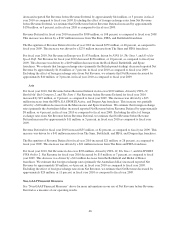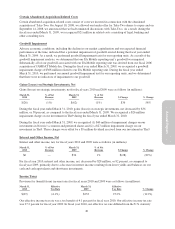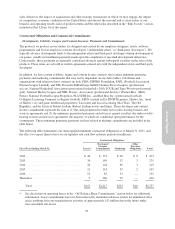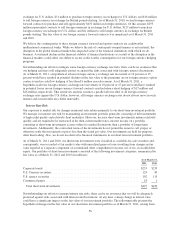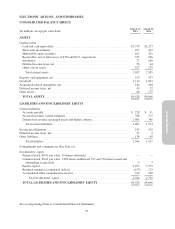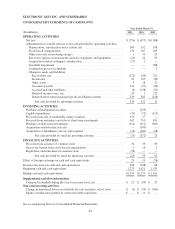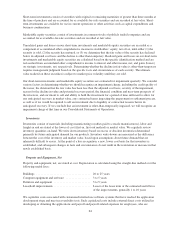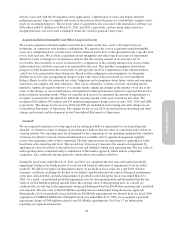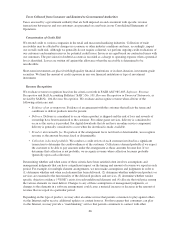Electronic Arts 2011 Annual Report Download - page 132
Download and view the complete annual report
Please find page 132 of the 2011 Electronic Arts annual report below. You can navigate through the pages in the report by either clicking on the pages listed below, or by using the keyword search tool below to find specific information within the annual report.
exchange for U.S. dollars, $31 million to purchase foreign currency in exchange for U.S. dollars, and $16 million
to sell foreign currency in exchange for British pounds sterling. As of March 31, 2010, we had foreign currency
forward contracts to purchase and sell approximately $431 million in foreign currencies. Of this amount, $293
million represented contracts to sell foreign currencies in exchange for U.S. dollars, $127 million to purchase
foreign currency in exchange for U.S. dollars and $11 million to sell foreign currency in exchange for British
pounds sterling. The fair value of our foreign currency forward contracts was immaterial as of March 31, 2011
and 2010.
We believe the counterparties to these foreign currency forward and option contracts are creditworthy
multinational commercial banks. While we believe the risk of counterparty nonperformance is not material, the
disruption in the global financial markets has impacted some of the financial institutions with which we do
business. A sustained decline in the financial stability of financial institutions as a result of the disruption in the
financial markets could affect our ability to secure credit-worthy counterparties for our foreign currency hedging
programs.
Notwithstanding our efforts to mitigate some foreign currency exchange rate risks, there can be no assurance that
our hedging activities will adequately protect us against the risks associated with foreign currency fluctuations.
As of March 31, 2011, a hypothetical adverse foreign currency exchange rate movement of 10 percent or 15
percent would have resulted in potential declines in the fair value of the premiums on our foreign currency option
contracts used in cash flow hedging of less than $1 million in each scenario. As of March 31, 2011, a
hypothetical adverse foreign currency exchange rate movement of 10 percent or 15 percent would have resulted
in potential losses on our foreign currency forward contracts used in balance sheet hedging of $17 million and
$26 million, respectively. This sensitivity analysis assumes a parallel adverse shift of all foreign currency
exchange rates against the U.S. dollar; however, all foreign currency exchange rates do not always move in such
manner and actual results may differ materially.
Interest Rate Risk
Our exposure to market risk for changes in interest rates relates primarily to our short-term investment portfolio.
We manage our interest rate risk by maintaining an investment portfolio generally consisting of debt instruments
of high credit quality and relatively short maturities. However, because short-term investments mature relatively
quickly and are required to be reinvested at the then-current market rates, interest income on a portfolio
consisting of short-term investments is more subject to market fluctuations than a portfolio of longer term
investments. Additionally, the contractual terms of the investments do not permit the issuer to call, prepay or
otherwise settle the investments at prices less than the stated par value. Our investments are held for purposes
other than trading. Also, we do not use derivative financial instruments in our short-term investment portfolio.
As of March 31, 2011 and 2010, our short-term investments were classified as available-for-sale securities and,
consequently, were recorded at fair market value with unrealized gains or losses resulting from changes in fair
value reported as a separate component of accumulated other comprehensive income, net of tax, in stockholders’
equity. Our portfolio of short-term investments consisted of the following investment categories, summarized by
fair value as of March 31, 2011 and 2010 (in millions):
As of March 31,
2011 2010
Corporate bonds ................................................................ $253 $233
U.S. Treasury securities .......................................................... 124 83
U.S. agency securities ............................................................ 102 115
Commercial paper ............................................................... 18 1
Total short-term investments ..................................................... $497 $432
Notwithstanding our efforts to manage interest rate risks, there can be no assurance that we will be adequately
protected against risks associated with interest rate fluctuations. At any time, a sharp change in interest rates
could have a significant impact on the fair value of our investment portfolio. The following table presents the
hypothetical changes in the fair value in our short-term investment portfolio as of March 31, 2011, arising from
56


